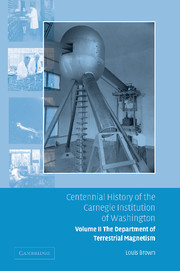Book contents
- Frontmatter
- Contents
- Foreword by Richard A. Meserve
- Preface
- 1 Establishment
- 2 Cruises and war
- 3 Expeditions
- 4 Measurements: magnetic and electric
- 5 The Fleming transition
- 6 The last cruise
- 7 The magnetic observatories and final land observations
- 8 The ionosphere
- 9 Collaboration and evaluation
- 10 The Tesla coil
- 11 The Van de Graaff accelerator
- 12 The nuclear force
- 13 Fission
- 14 Cosmic rays
- 15 The proximity fuze and the war effort
- 16 The Tuve transition
- 17 Postwar nuclear physics
- 18 The cyclotron
- 19 Biophysics
- 20 Explosion seismology
- 21 Isotope geology
- 22 Radio astronomy
- 23 Image tubes
- 24 Computers
- 25 Earthquake seismology
- 26 Strainmeters
- 27 The Bolton and Wetherill years
- 28 Astronomy
- 29 The solar system
- 30 Geochemistry
- 31 Island-arc volcanoes
- 32 Seismology revisited
- 33 Geochemistry and cosmochemistry
- 34 The Solomon transition
- 35 The support staff
- 36 Epilogue
- Notes
- Index
15 - The proximity fuze and the war effort
Published online by Cambridge University Press: 06 January 2010
- Frontmatter
- Contents
- Foreword by Richard A. Meserve
- Preface
- 1 Establishment
- 2 Cruises and war
- 3 Expeditions
- 4 Measurements: magnetic and electric
- 5 The Fleming transition
- 6 The last cruise
- 7 The magnetic observatories and final land observations
- 8 The ionosphere
- 9 Collaboration and evaluation
- 10 The Tesla coil
- 11 The Van de Graaff accelerator
- 12 The nuclear force
- 13 Fission
- 14 Cosmic rays
- 15 The proximity fuze and the war effort
- 16 The Tuve transition
- 17 Postwar nuclear physics
- 18 The cyclotron
- 19 Biophysics
- 20 Explosion seismology
- 21 Isotope geology
- 22 Radio astronomy
- 23 Image tubes
- 24 Computers
- 25 Earthquake seismology
- 26 Strainmeters
- 27 The Bolton and Wetherill years
- 28 Astronomy
- 29 The solar system
- 30 Geochemistry
- 31 Island-arc volcanoes
- 32 Seismology revisited
- 33 Geochemistry and cosmochemistry
- 34 The Solomon transition
- 35 The support staff
- 36 Epilogue
- Notes
- Index
Summary
When war enveloped Europe in 1939 the nuclear physics group of the Department recognized the serious crisis that faced Western civilization. At top of their concerns as citizens lay concerns imposed by their knowledge of what was transpiring with uranium fission. They were themselves active in obtaining data that went primarily to Fermi for his far-ranging calculations. Roberts published a paper sketching the possibilities of fission as a source of power, and back-of-the-envelope calculations of bomb designs dominated many informal discussions. The sudden and unexpected defeat of France, followed by the Battle of Britain in the summer of 1940, brought all of these concerns to a rapid focus. The group, Tuve, Hafstad, Roberts and Heydenburg, sought a research goal with direct application to preparing the nation for the struggle they were sure was coming.
There was little interest in the atomic bomb project that was coming into existence, although they cooperated in making the measurements wanted by others. They estimated that years would be required for its achievement, not to mention an enormous industrial commitment that might prove to be a misdirection of effort. Tuve's connections with the Navy, established during the ionosphere work, soon had him in consultation with ordnance officers, who were quite receptive to his offer of research talent.
The Navy's great concern was the vulnerability of ships to air attack. In the spectacular and public demonstrations after World War I by General Mitchell it had been established that an airplane could sink a battleship.
- Type
- Chapter
- Information
- Centennial History of the Carnegie Institution of Washington , pp. 109 - 116Publisher: Cambridge University PressPrint publication year: 2005



